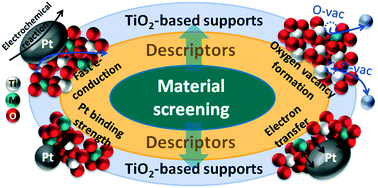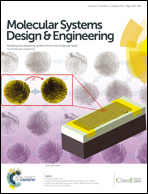Design of transition-metal-doped TiO2 as a multipurpose support for fuel cell applications: using a computational high-throughput material screening approach†
Abstract
Transition-metal-doped titanium oxide (TiO2, TiMO2) has great potential for resolving carbon corrosion in current applications of proton exchange membrane fuel cells. To quickly search the available materials, a screening methodology is proposed to screen TiMO2 support materials, where M is a doping element selected from the transition metals (TM) to modify the intrinsic properties of anatase-TiO2. A computational strategy was carried out by combining electronic structures and thermodynamic criteria based on high-throughput density functional theory calculations. Several key requirements that strongly influence the catalytic performance occurring on the catalyst systems of platinum (Pt)/TiO2-based supports, e.g., electrical conductivity, oxygen vacancy, Pt adsorption energy and the charge variation of deposited Pt, have been quantitatively assessed. Among all the key requirements, analysis of the electrochemical reaction indicates that a support material with good electrical conductivity is vital. Furthermore, the doping element not only affects the intrinsic properties of anatase-TiO2, but the resultant TiMO2 also changes the characteristics of the deposited Pt atoms. Combining considerations of oxygen vacancy formation energy and Pt adsorption behavior indicated that the strong metal support interactions result in charge variation of the deposited Pt. The key criteria were developed by a set of defined descriptors, then integrated into a guide map to effectively screen promising anatase-TiMO2 support materials. Using this approach, many systems were found which were potentially suitable to enhance the activity and durability of catalysts in several reactions crucial to the energy economy, e.g., the methanol oxidation reaction and the oxygen reduction reaction. The unification of experimental observations and first principle computational material screening offers a route to accelerating the design and development of TiO2-based support materials.



 Please wait while we load your content...
Please wait while we load your content...